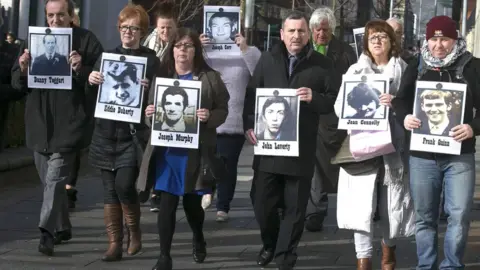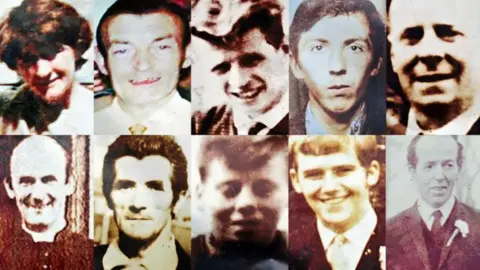Ballymurphy Inquest: 'A cry of horror I'll never forget'
 Colm Lenaghan/ Pacemaker Press
Colm Lenaghan/ Pacemaker PressA inquest has found that 10 people who were shot over a three-day period in Ballymurphy, west Belfast, in 1971, were "entirely innocent".
Coroner Mrs Justice Keegan said nine of the victims were shot by the Army, could not definitively say who shot the tenth.
The victims included a priest trying to help the wounded and a mother of eight.
Mrs Justice Keegan, who delivered her findings over the course of more than two hours, said the deaths took place during Northern Ireland's Troubles in a "highly charged and difficult environment".
BBC News NI reporter Will Leitch covered the inquest to its conclusion following 16 months of hearings.
He has reflected on some of the harrowing stories he heard during his "longest and most difficult assignment".

It was a cry of horror. A sharp, sudden cry of pain, of grief, of deep, deep sorrow.
A visceral cry which must have pierced the heart of every single person who heard it echo around courtroom 12 of the Laganside Courts complex in Belfast.
The courtroom gasped as waves of emotion rippled out from the jury box, where the families were sitting to watch witnesses give evidence on day 33 of the Ballymurphy Inquest.
The daughters of Joan Connolly comforted their sister.
She had just heard, for the very first time, graphic details of how her mother was shot, and died, alone and in great pain, just feet from a house where another woman inside was frantically trying to save her.
 Family photo
Family photoThat woman, now in the witness box, paused, and looked anxiously at the coroner to see if she should continue her evidence.
Margaret Elmore had, under oath, described what she remembered from August 1971, and knew that in doing what the court asked, had inadvertently awoken great sorrow.
The court rose, to allow time for everyone to recompose themselves.
That was just one painful moment in March 2019 during the Ballymurphy Inquest, but one which has stayed with me.
This story was about ordinary people and the quest for the truth of what happened 50 years ago.
I have watched and listened to many sad or upsetting court cases in my 30 years as a reporter.
But nothing prepares you for the cries of a woman who had just heard how half of her mother's face had been shot off.
In all, there had been more than 150 witnesses and 248 statements.
On my desk I now have four box files full of documents, notes, transcripts, TV and radio scripts.

Who were the victims?
- Father Hugh Mullan, 38, and Francis Quinn, 19, were shot in an area of open ground behind Springfield Park
- Daniel Teggart, 44, Joan Connolly, 44, Noel Phillips, 19, and Joseph Murphy, 41, were shot near the Henry Taggart Army base near Springfield Park
- John Laverty, 20, and Joseph Corr, 43, were shot at separate points at the top of Whiterock Road
- Edward Doherty, 31, was shot at the corner of Brittons Parade and Whiterock Road
- John McKerr, 49, was shot outside the old Corpus Christi Parish

Where the statement came from someone who could not attend, or was already dead, they were read out to the court, in full and at length.
I watched as witnesses gave their recollections, listened to the voices of former soldiers giving evidence from behind a curtain and concentrated as experts in forensic pathology or ballistics explained their findings.

I looked into the faces of former colonels and generals who waived their anonymity and tried to explain their command decisions.
I also looked on as barristers asked pointedly about the witnesses who did not appear and the documents which were never submitted as evidence.
In 1971, the coroner had a list of all the soldiers who claimed to have shot anyone, but in the intervening years that list was lost.
Several Army records, including some from the Parachute Regiment in 1971, are missing or incomplete.
"Witness X" offered to supply information about Ulster Volunteer Force (UVF) snipers in the area at the time, but despite giving answers to the coroner's investigators, he never appeared to testify in court.
Although several witnesses, including the former Sinn Féin president Gerry Adams, said they had seen Irish Republican Army (IRA) gunmen in the area, no one from the IRA came forward with any information.
Covering the Ballymurphy Inquest has been my longest and most difficult assignment, but the stories I tried my best to tell belonged to those people whose memories unfolded in the courtroom.
